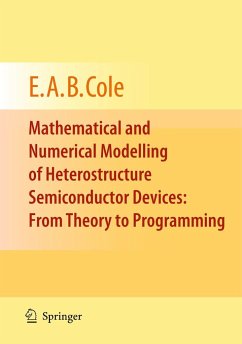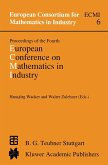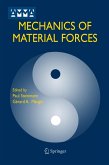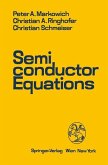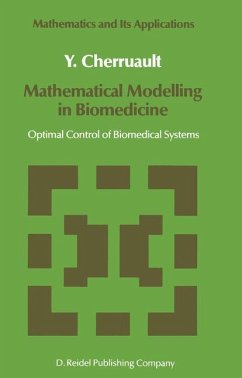The commercial development of novel semiconductor devices requires that their properties be examined as thoroughly and rapidly as possible. These properties are investigated by obtaining numerical solutions of the highly nonlinear coupled set of equations which govern their behaviour.
This book presents some of the mathematical and numerical techniques associated with the investigation. It begins with introductions to quantum and statistical mechanics. Later chapters then cover finite differences; multigrids; upwinding techniques; simulated annealing; mesh generation; and the reading of computer code in C++. The author explains how the methods can be adapted to the specific needs of device modelling, the advantages and disadvantages of each method, the pitfalls to avoid, and practical hints and tips for successful implementation. Sections of computer code are included to illustrate the methods used.
Part of my lecturing work in the School of Mathematics at the University of Leeds involved teaching quantum mechanics and statistical mechanics to mathematics undergraduates, and also mathematical methods to undergraduate students in the School of Electronic and Electrical Engineering at the University. The subject of this book has arisen as a result of research collaboration on device modelling with members of the School of Electronic and Electrical Engineering. I wanted to write a book which would be of practical help to those wishing to learn more about the mathematical and numerical methods involved in heteroju- tion device modelling. I have introduced only a comparatively small number of t- ics, and the reader may think that other important topics should have been included. But of the topics which I have introduced, I hope that I have given the reader some practical advice concerning the implementation of the methods which are discussed. This practical advice includes demonstrating how the implementation of the me- ods may be tailored to the speci?c device being modelled, and also includes some sections of computer code to illustrate this implementation. I have also included some background theory regarding the origins of the routines.
This book presents some of the mathematical and numerical techniques associated with the investigation. It begins with introductions to quantum and statistical mechanics. Later chapters then cover finite differences; multigrids; upwinding techniques; simulated annealing; mesh generation; and the reading of computer code in C++. The author explains how the methods can be adapted to the specific needs of device modelling, the advantages and disadvantages of each method, the pitfalls to avoid, and practical hints and tips for successful implementation. Sections of computer code are included to illustrate the methods used.
Part of my lecturing work in the School of Mathematics at the University of Leeds involved teaching quantum mechanics and statistical mechanics to mathematics undergraduates, and also mathematical methods to undergraduate students in the School of Electronic and Electrical Engineering at the University. The subject of this book has arisen as a result of research collaboration on device modelling with members of the School of Electronic and Electrical Engineering. I wanted to write a book which would be of practical help to those wishing to learn more about the mathematical and numerical methods involved in heteroju- tion device modelling. I have introduced only a comparatively small number of t- ics, and the reader may think that other important topics should have been included. But of the topics which I have introduced, I hope that I have given the reader some practical advice concerning the implementation of the methods which are discussed. This practical advice includes demonstrating how the implementation of the me- ods may be tailored to the speci?c device being modelled, and also includes some sections of computer code to illustrate this implementation. I have also included some background theory regarding the origins of the routines.
From the reviews:
"The book covers a wide spectrum of topics that are fundamental for modelling and simulation of semiconductor electron devices ... . It is addressed to undergraduate and graduate students in mathematics and electrical engineering as well as researchers who would like to get different perspectives on the subject. ... The monograph is self-contained since a standard background in calculus is enough to read it. This is surely a good textbook for Ph.D. students in applied mathematics." (Vittorio Romano, Mathematical Reviews, Issue 2011 e)
"This well-written book involves the basic physical theory of semiconductor device modelling and the numerical methods to solve the corresponding equations. ... Problems are formulated to improve the skill of the reader ... . In order to support the reader, in the implementation of the methods, some simple codes written in C++ are included. ... A great advantage of this monograph consists in the presentation of the whole cycle of semiconductor device modelling ... ." (Georg Hebermehl, Zentralblatt MATH, Vol. 1252, 2012)
"The book covers a wide spectrum of topics that are fundamental for modelling and simulation of semiconductor electron devices ... . It is addressed to undergraduate and graduate students in mathematics and electrical engineering as well as researchers who would like to get different perspectives on the subject. ... The monograph is self-contained since a standard background in calculus is enough to read it. This is surely a good textbook for Ph.D. students in applied mathematics." (Vittorio Romano, Mathematical Reviews, Issue 2011 e)
"This well-written book involves the basic physical theory of semiconductor device modelling and the numerical methods to solve the corresponding equations. ... Problems are formulated to improve the skill of the reader ... . In order to support the reader, in the implementation of the methods, some simple codes written in C++ are included. ... A great advantage of this monograph consists in the presentation of the whole cycle of semiconductor device modelling ... ." (Georg Hebermehl, Zentralblatt MATH, Vol. 1252, 2012)

